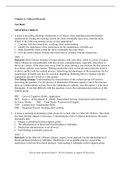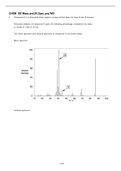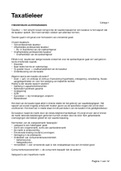Chapter 6: Cultural Diversity
Test Bank
MULTIPLE CHOICE
1.A nurse is providing discharge instructions to a Chinese client regarding prescribed dietary modifications. During the teaching session the client continually turns away from the nurse. Which of the following nursing actions is most appropriate?
1.Continue with the instructions, verifying client understanding.
2.Identify the importance of the instructions for the maintenance of health care.
3.Walk around the client so that the nurse continually faces the client.
4.Give the client a dietary booklet and return later to continue with the instructions.
ANS:1
Rationale: Most Chinese maintain a formal distance with each other, which is a form of respect. Many Chinese are uncomfortable with face-to-face communications, especially when there is direct eye contact. If the client turns away from the nurse during a conversation, the best action is
to continue with the conversation. Walking around the client so that the nurse faces the client is in direct conflict with the cultural practice. Identifying the importance of the instructions for the maintenance of health care may be viewed as degrading. Returning later to continue with the explanation may be viewed as a rude gesture.
Test-Taking Strategy: Understanding the characteristics of this cultural group will assist in answering the question. Use the process of elimination. Eliminate options 2 and 4 first because these are nontherapeutic actions. From the remaining two options, note that option 1 is the most therapeutic. If you had difficulty with this question, review the communication practices of this cultural group.
DIF:Level of Cognitive Ability: Application
REF:Giger, J., & Davidhizar, R. (2004). Transcultural nursing: Assessment and intervention. St. Louis: Mosby. OBJ:Client Needs: Psychosocial Integrity
TOP:Content Area: Fundamental Skills
MSC:Integrated Process: Teaching and Learning
2.A nurse is assisting in preparing a plan of care for a client who is a Jehovah’s Witness. The client has been told that surgery is necessary. Considering the client’s religious preferences, the nurse documents that:
1.Surgery is prohibited in this religious group.
2.The administration of blood and blood products is forbidden.
3.Medication administration is not allowed.
4.Faith healing is primarily practiced.
ANS:2
Rationale: In the Jehovah’s Witness religion, surgery is not opposed, but the administration of blood and blood products is forbidden. Medication is an acceptable practice except if the medication is derived from blood products. Faith healing is forbidden in this religious group.
Elsevier items and derived items © 2010 by Saunders, an imprint of Elsevier Inc. Test Bank
Test-Taking Strategy: Understanding the characteristics of this religious group will assist in answering the question. Remember that the administration of blood and any associated blood products is forbidden in this religion. Review the characteristics of this religious group if you had
difficulty with this question.
DIF:Level of Cognitive Ability: Comprehension
REF:Nies, M., & McEwen, M. (2007). Community health nursing: Promoting the health of populations (4th ed.). St. Louis: Saunders. OBJ:Client Needs: Psychosocial Integrity
TOP:Content Area: Fundamental Skills
MSC:Integrated Process: Nursing Process/Implementation
3.A nurse is preparing to deliver a food tray to a client whose religion is Judaism. The nurse checks
the food on the tray and notes that the client has received a roast beef dinner with whole milk as a beverage. Which of the following actions will the nurse take?
1.Deliver the food tray to the client.
2.Call the dietary department and ask for a new meal tray.
3.Replace the whole milk with fat-free milk.
4.Ask the dietary department to replace the roast beef with pork.
ANS:2
Rationale: In the Jewish religion, the dairy-meat combination is not acceptable. Pork and pork products are not allowed in the traditional Jewish religion. The only correct nursing action is to ask the dietary department to deliver a new meal tray.
Test-Taking Strategy: Use the process of elimination and knowledge that the dairy-meat combination is not acceptable in this religion to answer the question. This knowledge will assist in eliminating options 1, 3, and 4. Also note that option 2 is the umbrella option. Review the dietary rules of this religious group if you had difficulty with this question.
DIF:Level of Cognitive Ability: Application
REF:Harkreader, H., & Hogan, M. (2007). Fundamentals of nursing (3rd ed.). St. Louis: Saunders. OBJ:Client Needs: Psychosocial Integrity
TOP:Content Area: Fundamental Skills
MSC:Integrated Process: Nursing Process/Implementation
4.A nurse educator is describing the yin and yang theory of the ancient Chinese philosophy of Tao to a group of nursing students. The nurse explains that foods are classified as hot and cold in this theory and are transformed into yin and yang energy when metabolized by the body. The nursing student understands this theory when the student verbalizes that a client who practices this belief:
1.Consumes cold foods when a “hot” illness is present
2.Consumes hot foods when a “hot” illness is present
3.Believes that yin foods are hot foods
4.Believes that yang foods are cold foods
ANS:1
Elsevier items and derived items © 2010 by Saunders, an imprint of Elsevier Inc.6-2 Test Bank
Rationale: In the yin and yang theory, health is believed to exist when all aspects of the person are in perfect balance. Foods are classified as hot or cold and are transformed into yin and yang energy when metabolized by the body. Yin foods are cold, and yang foods are hot. Cold foods are
eaten when one has a hot illness and hot foods are eaten when one has a cold illness.
Test-Taking Strategy: Knowledge regarding the theory of yin and yang is required to answer this
question. Remember that yin foods are cold and yang foods are hot; cold foods are eaten when one has a hot illness and hot foods are eaten when one has a cold illness. Review this theory if you are unfamiliar with it.
DIF:Level of Cognitive Ability: Comprehension
REF:Nies, M., & McEwen, M. (2007). Community health nursing: Promoting the health of populations (4th ed.). St. Louis: Saunders. OBJ:Client Needs: Psychosocial Integrity
TOP:Content Area: Fundamental Skills
MSC:Integrated Process: Teaching and Learning
5.A nurse is planning to instruct the Hispanic-American client about nutrition and dietary restrictions. When developing the plan for the instructions, the nurse is aware that this ethnic group:
1.Enjoys foods that lack color, flavor, and texture
2.Primarily eats raw fish
3.Enjoys eating red meat
4.Views food as a primary form of socialization
ANS:4
Rationale: Mexican foods are rich in color, flavor, texture, and spiciness. In the Mexican culture,
any occasion is seen as a time to celebrate with food and enjoy the companionship of family and friends. Because food is a primary form of socialization in the Mexican culture, Hispanic Americans may have difficulty adhering to a prescribed diet. Asian Americans eat raw fish, rice, and soy sauce. European Americans prefer carbohydrates and red meat.
Test-Taking Strategy: Knowledge regarding the food practices and preferences and the meaning of food in the Hispanic-American culture is required to answer this question. Remember that food is a primary form of socialization in the Mexican culture. If you had difficulty with this question, review the food preferences associated with this culture.
DIF:Level of Cognitive Ability: Comprehension
REF:Giger, J., & Davidhizar, R. (2004). Transcultural nursing: Assessment and intervention. St. Louis: Mosby. OBJ:Client Needs: Psychosocial Integrity
TOP:Content Area: Fundamental Skills
MSC:Integrated Process: Nursing Process/Planning
6.A nursing student is discussing cultural issues in a clinical conference. The nursing instructor asks the student to describe ethnocentrism. Which of the following if stated by the student indicates a lack of understanding of the issue of ethnocentrism?
1.“It is a tendency to view one’s own ways as best.”
2.“It is acting in a manner that is superior to other cultures.”
3.“It is believing that one’s own ways are the only acceptable way.”
4.“It is imposing one’s beliefs on individuals from another culture.”
Elsevier items and derived items © 2010 by Saunders, an imprint of Elsevier Inc.6-3 Test Bank
ANS:4
Rationale: Ethnocentrism is a tendency to view one’s own ways of life as the most desirable, acceptable, or best and to act in a superior manner toward another culture. Cultural imposition is the tendency to impose one’s own beliefs, values, and patterns of behavior on individuals from another culture.
Test-Taking Strategy: Note the strategic words “lack of understanding.” Use the process of elimination, and note that options 1, 2, and 3 are comparable or alike. Additionally, knowledge of
the concept of ethnocentrism will direct you to option 4. If you had difficulty with this question, review culturally related concepts.
DIF:Level of Cognitive Ability: Comprehension
REF:Nies, M., & McEwen, M. (2007). Community health nursing: Promoting the health of populations (4th ed.). St. Louis: Saunders. OBJ:Client Needs: Psychosocial Integrity
TOP:Content Area: Fundamental Skills
MSC:Integrated Process: Teaching and Learning
7.A nurse is assigned to collect data from a Hispanic-American client during the hospital admission. On initial meeting of the client, the nurse should plan to:
1.Greet the client with a handshake.
2.Avoid touching the client.
3.Avoid any affirmative nods during the conversations with the client.
4.Smile and use humor throughout the entire admission process.
ANS:1
Rationale: To demonstrate respect, compassion, and understanding, health care providers should greet Hispanic-American clients with a handshake. On establishing rapport, providers may further demonstrate approval and respect through touch, smiling, and affirmative nods of the head. Given the diversity of dialects and the nuances of language, culturally congruent use of humor is difficult to accomplish and therefore should be avoided.
Test-Taking Strategy: Knowledge regarding the cultural communication patterns of the Hispanic American is required to answer this question. Note the strategic words “initial meeting.” Reading
each option carefully and focusing on these strategic words will direct you to option 1. Review the characteristics of this cultural group if you had difficulty with this question.
DIF:Level of Cognitive Ability: Application
REF:Giger, J., & Davidhizar, R. (2004). Transcultural nursing: Assessment and intervention. St. Louis: Mosby. OBJ:Client Needs: Psychosocial Integrity
TOP:Content Area: Fundamental Skills
MSC:Integrated Process: Nursing Process/Planning
8.A nurse is providing care to a Cuban-American client who is terminally ill. Numerous family members are present most of the time, and many of the family members are very emotional. The most appropriate nursing plan is to:
1.Restrict the number of family members visiting at one time.
2.Inform the family that emotional outbursts are to be avoided.
3.Request permission to move the client to a private room, and allow the family Elsevier items and derived items © 2010 by Saunders, an imprint of Elsevier Inc.6-4






